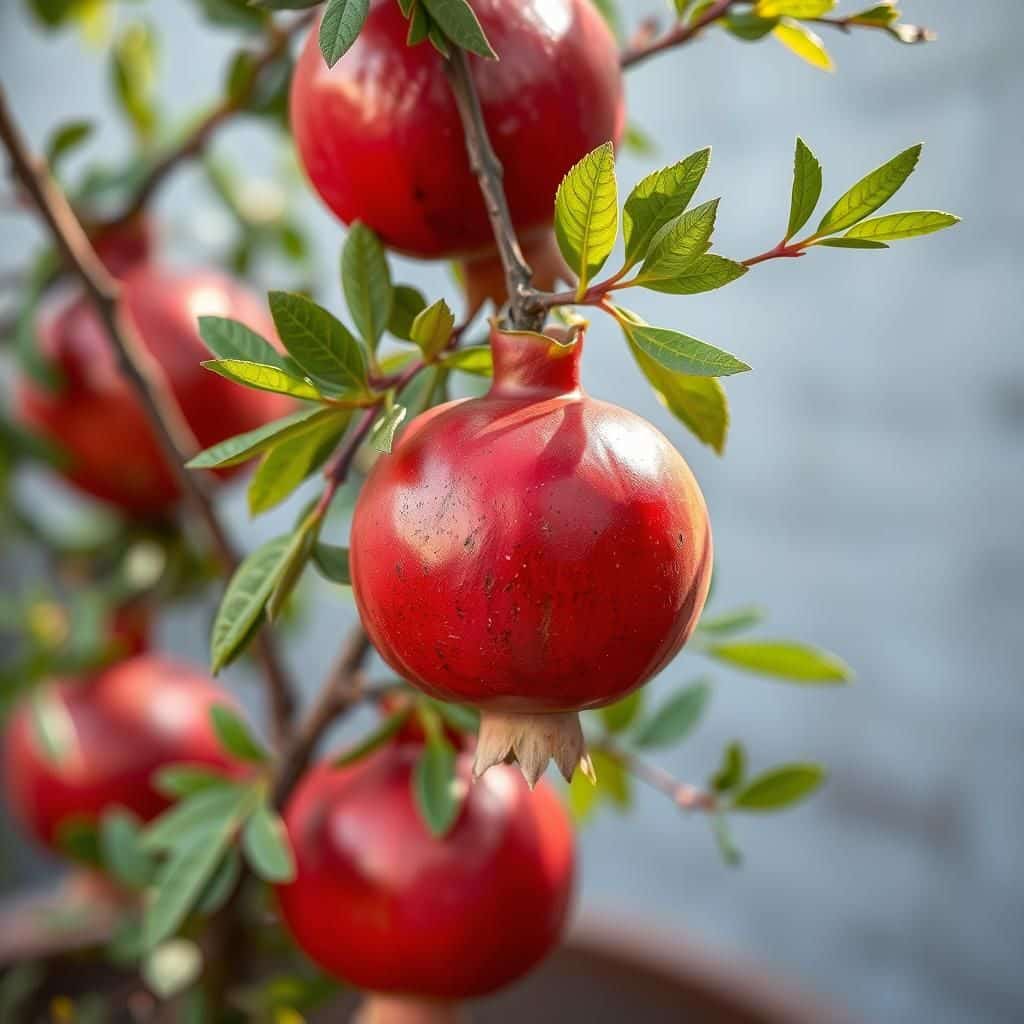How to Successfully Grow Pomegranate Tree from Seed: A Step-by-Step Guide

Growing a pomegranate tree from seed can be a rewarding and fulfilling endeavor for gardening enthusiasts. This vibrant fruit not only enhances your landscape with its beautiful blossoms but also offers delicious, nutrient-rich produce. However, cultivating a pomegranate tree requires patience, attention to detail, and the right techniques. In this step-by-step guide, we will explore the essential processes of planting and nurturing pomegranate seeds, ensuring you set a solid foundation for successful growth. Whether you’re a novice gardener or someone with experience, this article will provide valuable tips and insights to help you thrive with your pomegranate tree journey.
How to Successfully Grow a Pomegranate Tree from Seed
Growing a pomegranate tree from seed can be a rewarding endeavor, allowing you to witness the entire lifecycle of this beautiful and fruitful plant. To start, you'll need to collect seeds from a ripe pomegranate fruit, ideally from an organic source to prevent any hybridization. After rinsing and drying the seeds, you can either plant them directly in soil or allow them to germinate by soaking them in water for 24 hours. The key to successful germination is to provide a warm and humid environment, as pomegranate seeds require temperatures around 70°F to sprout. Once the seedlings develop a few leaves, they can be transplanted into larger pots or directly into well-draining soil with plenty of sunlight. Remember that patience is essential, as it may take several years for the tree to produce its first juicy fruits.
Collecting Pomegranate Seeds
Collecting seeds from a ripe pomegranate fruit involves carefully extracting the seeds to ensure their viability. Choose a healthy and ripe fruit, cut it open, and gently separate the seeds from the surrounding pulp. Rinse the seeds in water to remove any residue, and spread them out on a paper towel to dry completely. This preparation is crucial because moisture can lead to mold growth, hindering the germination process.
Preparing Seeds for Germination
Before planting, it's beneficial to prepare the seeds to increase germination rates. You can soak the seeds in water for approximately 24 hours to help soften the seed coat. This process mimics the natural conditions that seeds would experience in the wild, allowing them to absorb moisture and promote quicker sprouting. After soaking, let the seeds dry on a towel for a few hours before planting them in soil.
Planting Pomegranate Seeds
When planting the prepared seeds, use a well-draining potting mix in small pots or seed trays and scatter the seeds on the surface, covering them lightly with soil. Water the planting site gently to settle the soil, ensuring it remains moist but not waterlogged. Keeping the pots in a warm location with plenty of light is crucial for encouraging germination, as pomegranate seeds thrive in bright conditions.
See also:
Transplanting Seedlings
Once the seedlings have grown several inches tall and developed multiple leaves, it’s time to transplant them into larger pots or the garden. This is usually around 8 to 12 weeks after planting the seeds. Choose a sunny location with well-draining soil, and carefully transplant each seedling, ensuring that the root system is not disturbed. Water the newly transplanted seedlings thoroughly to help them establish in their new environment.
Maintaining Healthy Pomegranate Trees
To promote healthy growth of your pomegranate trees, regular care is essential. Ensure they receive at least 6 hours of direct sunlight daily and water them consistently, allowing the soil to dry slightly between waterings. Fertilize the trees with a balanced fertilizer during the growing season to enhance their nutrient uptake. Additionally, pruning your pomegranate tree can help maintain its shape and encourage better air circulation, resulting in healthier growth and improved fruit production.
| Step | Action | Details |
|---|---|---|
| 1 | Collect Seeds | Extract seeds from ripe pomegranate and rinse. |
| 2 | Prepare Seeds | Soak seeds for 24 hours to promote germination. |
| 3 | Plant Seeds | Use well-draining soil and cover lightly. |
| 4 | Transplant Seedlings | Move seedlings to larger pots or garden location. |
| 5 | Maintain Trees | Ensure sunlight, consistent watering, and fertilization. |
Essential Tips for Nurturing Your Pomegranate Seedlings
To successfully grow pomegranate trees from seeds, it's crucial to establish a proper nurturing environment for your seedlings. Start by choosing a well-draining potting mix and ensuring that your pots have drainage holes. Provide the seedlings with adequate sunlight, ideally around 6-8 hours of direct sunlight per day, and maintain a consistent watering schedule – allowing the soil to slightly dry out between waterings. This will promote strong root development and healthy leaf growth, setting the stage for robust future trees.
Choosing the Right Seeds
Selecting high-quality pomegranate seeds is vital for the success of your growing journey. Look for seeds from reputable sources or fresh fruit, ensuring they are fully mature and disease-free. Avoid seeds that have been packaged for long periods, as their viability may decrease over time. Fresh seeds guarantee a better germination rate, leading to seedlings with a higher chance of thriving.
Preparing the Seeds for Planting
Before planting, it's beneficial to prepare the seeds properly to enhance germination. This involves soaking the seeds in water for 24 hours to help soften the outer coating and initiate the germination process. After soaking, clean the seeds gently to remove any remaining pulp, then allow them to dry for a few hours. This treatment significantly boosts the chances of successful sprouting once planted in a suitable medium.
See also:
Planting Depth and Spacing
When it comes time to plant, pay close attention to planting depth and spacing. The seeds should be planted about ¼ to ½ inch deep in the soil, ensuring they have enough cover while still being close to the surface for sunlight exposure. Additionally, if planting multiple seeds, maintain a distance of at least a few inches apart to promote healthy air circulation and reduce competition for resources among seedlings.
Watering Techniques for Young Plants
Watering young pomegranate plants requires a careful balance to avoid both underwatering and overwatering. When the topsoil feels slightly dry, gently water the seeds, allowing the excess to drain away. Employ a sprayer or a watering can to provide a gentle stream of water, promoting consistent moisture levels without disrupting the soil structure. Adequate watering practices will facilitate strong growth and help prevent root rot.
Monitoring and Managing Growth Conditions
Consistent monitoring of your seedlings is critical for ensuring their healthy development. Pay attention to light, temperature, and humidity as pomegranate plants thrive in warm environments. If the seedlings appear weak or leggy, consider adjusting their light exposure or rotating them to ensure all sides receive equal light. Regularly check for pests or diseases, taking immediate action if issues arise, as early intervention can save your young plants from decline.
Questions from Our Readers
Can I grow a pomegranate tree from seed?
Yes, you can grow a pomegranate tree from seed, although it's important to note that the new tree may not produce fruit that is identical to the parent plant. The seeds should be extracted from a ripe fruit, cleaned, and then treated properly for the best chance of germination.
How do I prepare pomegranate seeds for planting?
To prepare pomegranate seeds for planting, start by removing them from the fruit and rinsing them in water to get rid of any fruit residue. After cleaning, it's advisable to soak the seeds in water for about 24 hours before planting to enhance their chances of germination.
See also:
What is the ideal environment for growing pomegranate trees from seed?
Pomegranate trees thrive in warm climates with plenty of sunlight. They prefer well-drained soil and a location that gets at least six hours of sunlight each day, making it essential to choose the right environment for successful growth from seed.
How long does it take for pomegranate seeds to germinate?
Pomegranate seeds typically take about 2 to 6 weeks to germinate, depending on the conditions provided. Maintaining warmth and consistent moisture during the germination period can significantly enhance the chances of sprouting.
https://youtube.com/watch?v=qS3OmcknAZw
If you want to read more articles like How to Successfully Grow Pomegranate Tree from Seed: A Step-by-Step Guide, we recommend you check out our Seeds category.
Leave a Reply
Related Articles